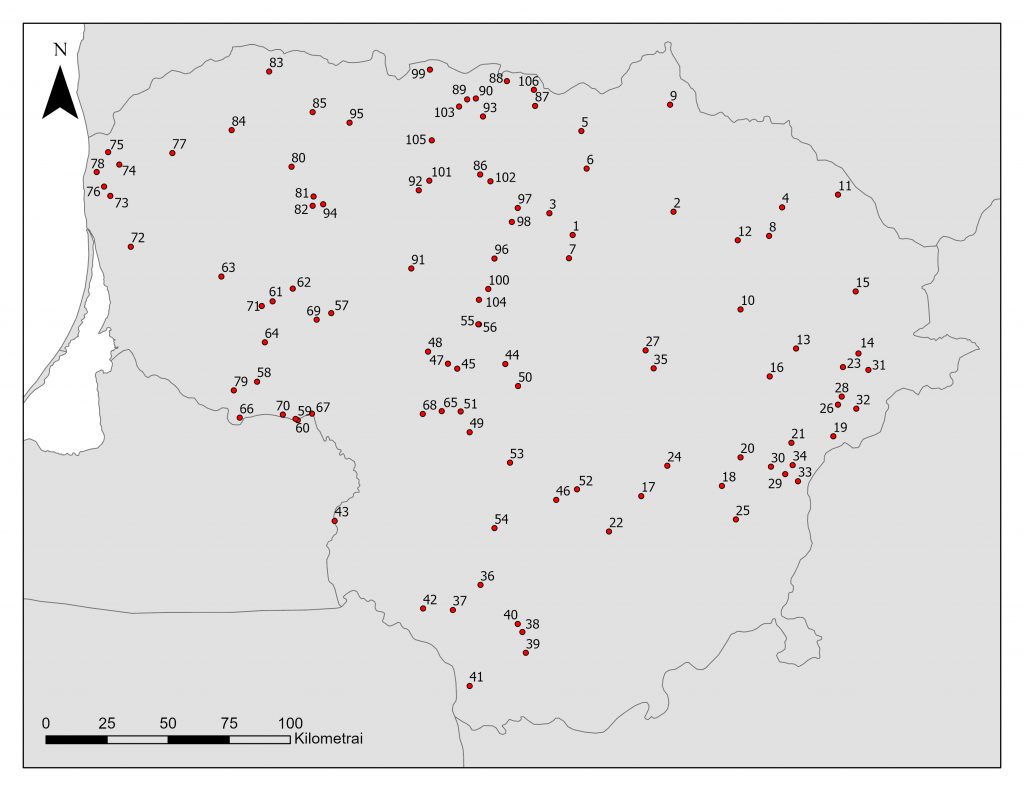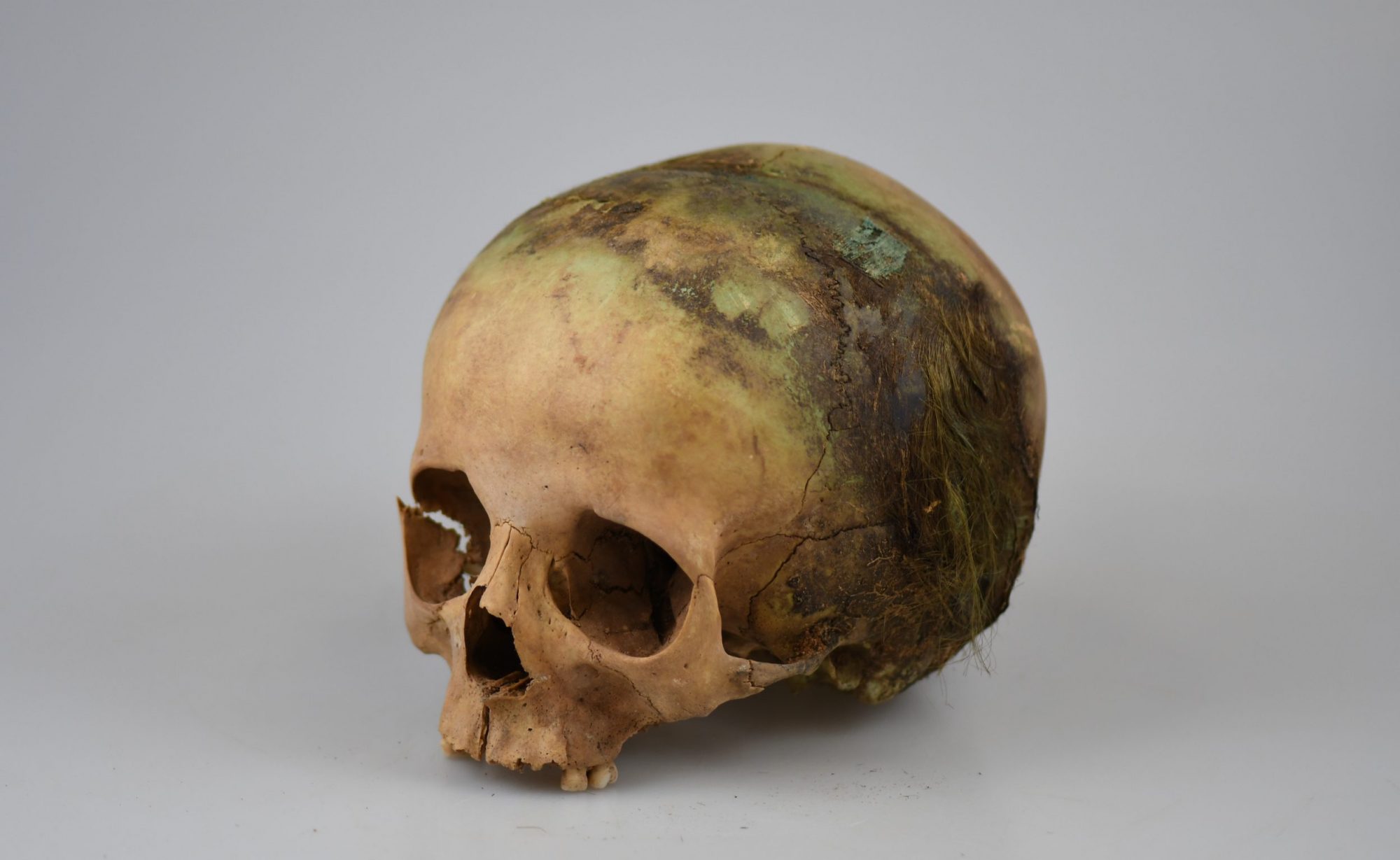The Bronze Age in Lithuania is considered to be the archeological period between the Stone Age and the Iron Age. It covers the period from about 1600 to 800 BC, although only units of bronze articles are found in the territory of Lithuania. The Iron Age began at 800 BC and lasted until the 12th century AD. It is characterized by the use of iron tools and weapons.
In the Bronze Age, the custom of burning the dead became widespread in the territory of Lithuania. This tradition lasted until the early Iron Age, thus most of the available anthropological material from this period is cremated remains. Inhumations are extremely rare and often incidental, e.g. late Neolithic-Bronze Age finds have been discovered in the peatlands of Kirsna (Lazdijai district) and Turlojiškė (Marijampolė district), including the remains of 6 young to middle-aged males.
The Iron Age, which lasted a little over a thousand years, is not only a long but also an extremely important epoch in which the Baltic tribes were finally formed. At the same time, it is a period of great turning points in European history, laying the foundations for the contours of today’s Europe. The tribes that existed in the territory of Lithuania at that time, although being far away from the main events of Europe – the formation and collapse of ancient Rome, and the beginning of the migration period – did not escape their influence on their internal development. Already at the beginning of the period, the large and long-lived culture of Stroked pottery collapsed and was replaced by the peculiar archeological cultures that flourished and eventually formed the Baltic cultures well known to us. About 1st-2nd c. AD the Balts were making a tremendous progress in learning to extract an iron from the local ball ore. The constant movement of various tribes around the fringes of the Baltic settlements not only changed the direction of trade relations, but also forced to take care of security. This is reflected in the emerging mounds and the first tombs of the so-called dukes. At the end of the migration period, the peace and stability of the Baltic tribes are observed: settlements and burial monuments exist in the same places for several hundred years. However, the unrest does not bypass the coastal lands where the 9th-10th c. military and economic expansion of the Vikings begins. At the same time, the Polish and Russian states are born, largely determining the subsequent geopolitical situation and the birth of the future Lithuanian state.

The Bronze and Iron Age anthropological collection constitutes of 106 archaeological sites located in the territory of present-day Lithuania. The total amount of Bronze and Iron Age material consists of 1904 skulls and 917 post-cranial skeletons:
| Site name | District/City | Skulls (N) | Postcranial skeletons (N) | |
| 1 | Aleknonys | Alytaus | 1 | – |
| 2 | Alinka (Raistinė) | Trakų | 1 | – |
| 3 | Aukštieji Rusokai | Vilniaus | 1 | – |
| 4 | Baitai | Klaipėdos | 1 | – |
| 5 | Baliuliai | Švenčionių | 1 | – |
| 6 | Berčiūnai | Panevėžio | 29 | 16 |
| 7 | Bernotai | Vilniaus | 1 | 1 |
| 8 | Čiukiškiai | Kaišiadorių | 2 | – |
| 9 | Dargužiai | Pakruojo | 1 | – |
| 10 | Dauglaukis | Tauragės | 2 | 2 |
| 11 | Delnica | Lazdijų | 1 | – |
| 12 | Didžiagrašiai | Kupiškio | 4 | 2 |
| 13 | Diktarai | Anykščių | 6 | 3 |
| 14 | Diržiai | Pakruojo | 47 | 19 |
| 15 | Dvareliškės (Kriukai) | Joniškio | 6 | 12 |
| 16 | Dvyliškis-Paraisčiai | Vilniaus | 1 | 1 |
| 17 | Dzirmiškės | Alytaus | 1 | 1 |
| 18 | Ėgliškiai (Anduliai) | Kretingos | 1 | – |
| 19 | Eitulionys | Trakų | 6 | 3 |
| 20 | Gėluva | Raseinių | 3 | 2 |
| 21 | Genčai | Kretingos | 34 | 4 |
| 22 | Gilbonys | Panevėžio | 3 | 4 |
| 23 | Guogų (Piliuonos) piliakalnis | Kauno | 1 | 1 |
| 24 | Jauneikiai | Joniškio | 59 | 8 |
| 25 | Joniškis (miesto aikštė) | Joniškio | 1 | 1 |
| 26 | Juodsodė | Telšių | 1 | – |
| 27 | Kalniškiai | Raseinių | 80 | 20 |
| 28 | Kaltanėnai-Degutinė | Širvintų | 1 | – |
| 29 | Kazikėnai | Jurbarko | 3 | 3 |
| 30 | Kejėnai | Raseinių | 8 | 5 |
| 31 | Kernavė | Širvintų | 1 | 1 |
| 32 | Kirsna (Turlojiškė) | Kalvarijos | 6 | 1 |
| 33 | Kriemala | Kauno | 2 | 2 |
| 34 | Krikštonys | Lazdijų | 1 | – |
| 35 | Kubiliškis | Rokiškio | 1 | 1 |
| 36 | Kuršiai | Kelmės | 1 | 1 |
| 37 | Labdarių g. 8A | Vilnius | 1 | 1 |
| 38 | Labūnava | Kėdainių | 6 | – |
| 39 | Lauksvydai | Kauno | 9 | 4 |
| 40 | Lazdininkai (Kalnalaukis) | Kretingos | 11 | – |
| 41 | Lieporiai | Šiaulių | 18 | – |
| 42 | Lygalaukiai | Zarasų | 1 | – |
| 43 | Linksmėnai | Joniškio | 2 | 1 |
| 44 | Liūlinė III | Švenčionių | 2 | 1 |
| 45 | Maisiejūnai | Kaišiadorių | 2 | 4 |
| 46 | Mankūnai I | Alytaus | 1 | 1 |
| 47 | Marvelė | Kauno | 798 | 409 |
| 48 | Maudžiorai | Kelmės | 40 | 33 |
| 49 | Miškiniai | Anykščių | 4 | – |
| 50 | Naudvaris | Jurbarko | 1 | – |
| 51 | Naujasis Obelynas | Šilalės | 3 | 1 |
| 52 | Noreliai | Pasvalio | 2 | 3 |
| 53 | Obeliai | Ukmergės | 56 | 57 |
| 54 | Paduobė-Šaltaliūnė III | Švenčionių | 1 | 1 |
| 55 | Pagrybis | Šilalės | 113 | 24 |
| 56 | Paįstriečiai | Pasvalio | 1 | – |
| 57 | Pakalniai | Vilniaus | 2 | 1 |
| 58 | Pakrauglė | Vilniaus | 1 | 1 |
| 59 | Papilė | Akmenės | 10 | 11 |
| 60 | Papiškės | Švenčionių | 1 | – |
| 61 | Paragaudis | Šilalės | 3 | – |
| 62 | Pašatrijos piliakalnis | Telšių | 9 | 9 |
| 63 | Pašekščiai | Molėtų | 6 | 5 |
| 64 | Pašušvys | Kėdainių | 1 | – |
| 65 | Pavajuonys-Rėkučiai | Ignalinos | 2 | 2 |
| 66 | Pavirvytė-Gudai | Akmenės | 48 | 7 |
| 67 | Pažarstis | Prienų | 1 | – |
| 68 | Peršaukštis-Kasčiukai | Švenčionių | 2 | 2 |
| 69 | Piepaliai | Radviliškio | – | 4 |
| 70 | Pilviškės | Vilniaus | 1 | – |
| 71 | Plauciškiai | Pakruojo | 12 | 5 |
| 72 | Plinkaigalis | Kėdainių | 286 | 156 |
| 73 | Pryšmančiai | Kretingos | 8 | 6 |
| 74 | Raginėnai | Radviliškio | 1 | – |
| 75 | Reketė | Kretingos | 1 | – |
| 76 | Rekošaičiai | Raseinių | 1 | 3 |
| 77 | Rokėnai | Ignalinos | 1 | 1 |
| 78 | Rudesa | Molėtų | 2 | 2 |
| 79 | Santaka | Vilniaus | 3 | – |
| 80 | Seredžius | Jurbarko | 16 | 2 |
| 81 | Smalininkai | Jurbarko | 1 | – |
| 82 | Sodėnai | Šilutės | 2 | – |
| 83 | Stanaičiai | Vilkaviškio | 4 | 4 |
| 84 | Stungiai | Joniškio | 4 | 3 |
| 85 | Šašiai | Radviliškio | 2 | 2 |
| 86 | Šaukėnai | Tauragės | 1 | – |
| 87 | Šereitlaukis | Tauragės | 3 | 1 |
| 88 | Šiaulių miesto centras | Šiauliai | 2 | 1 |
| 89 | Šukioniai | Pakruojo | 3 | 1 |
| 90 | Ukmergė (šulinys) | Ukmergė | 1 | 1 |
| 91 | Upytė | Panevėžio | 2 | 2 |
| 92 | Užpelkiai | Kretingos | 9 | – |
| 93 | Užupiai | Joniškio | 2 | 2 |
| 94 | Vaineikiai | Rokiškio | 8 | 2 |
| 95 | Vaitiekūnai | Radviliškio | 15 | 4 |
| 96 | Valdomai | Šiaulių | 5 | 8 |
| 97 | Veliuona | Jurbarko | 1 | – |
| 98 | Vėluikiai | Tauragės | 3 | 3 |
| 99 | Viešvilės kapinynas II | Jurbarko | 1 | – |
| 100 | Vinkšniniai | Biržų | 5 | 7 |
| 101 | Zapsė 5 | Lazdijų | 3 | – |
| 102 | Zastaučiai | Mažeikių | 3 | 1 |
| 103 | Žaduvėnai | Telšių | 4 | 3 |
| 104 | Žeimelis | Pakruojo | 1 | – |
| 105 | Žemaičių Kalvarija | Plungės | 1 | 1 |
| 106 | Žviliai | Šilalės | 9 | – |
The Iron Age collection is characterized by a selective matter: only well-preserved skulls and long bones were collected and analyzed. Fragmented skulls, long bones affected by erosion, all smaller skeletal parts have been reburied, so the distribution of sex and different age groups may be unrepresentative.
Below is a description of the anthropological material of the most abundant protected Bronze and Iron Age burial objects. We note that the anthropological material of all these objects, except for the Marvelė burial ground, consists only of skulls and long bones.
